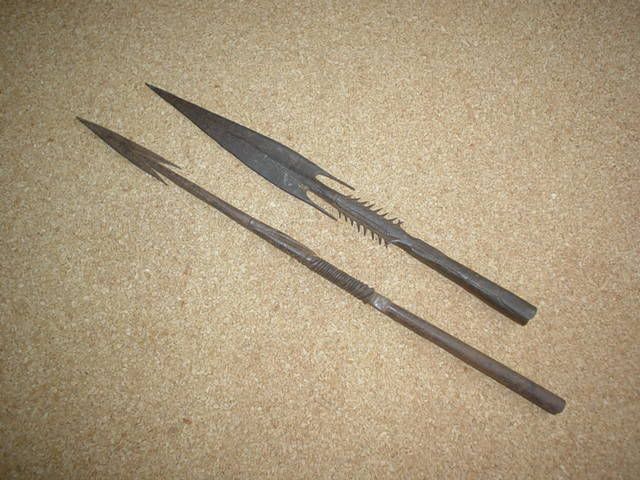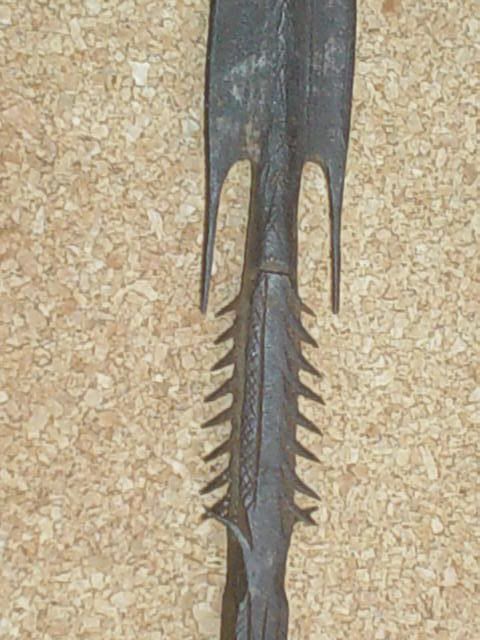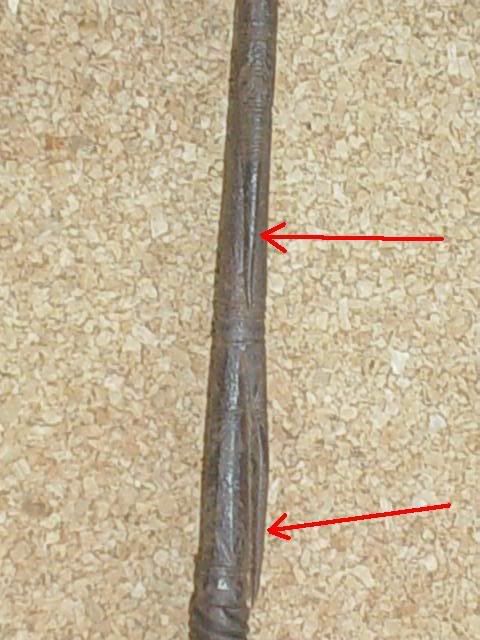
 |
|
|
#1 |
|
Member
Join Date: Jan 2006
Location: Kent
Posts: 2,653
|
Very pleased to have added these three spears to my collection. Beautifuly balanced ( I have to keep resisting the urge to throw them....everytime I pick one up
 ) ) Lovely patina on the shafts, some age cracking. Beautifly forged heads .....and those barbs  . It seems that the spearheads on two of them are purely to create an 'entry wound' just large enough to allow the barbs to penetrated. These are hunting/war spears (all the references I can find make no distinction between hunting/war spear), Obviously from the point of view of an animal, once speared it would be very difficult / painful to remove, the thickened shaft with barbs, would also keep the wound 'open' allowing faster blood loss. In the case of warfare, the same applies.....nasty. . It seems that the spearheads on two of them are purely to create an 'entry wound' just large enough to allow the barbs to penetrated. These are hunting/war spears (all the references I can find make no distinction between hunting/war spear), Obviously from the point of view of an animal, once speared it would be very difficult / painful to remove, the thickened shaft with barbs, would also keep the wound 'open' allowing faster blood loss. In the case of warfare, the same applies.....nasty.I can find no reference to any poison or venom used on this type of spear. Although these spears are likely Zande, I cannot believe there are no other possible sources (tribes) for this style of spear. Has anyone any suggestions ? These spears were alledgedly brought back at the time of the Boer War (not certain whether 1st or 2nd). I am awaiting further details.These were in the family for a very long time ...the seller is getting details from an aged relative But age wise I have no problem with late 19thC. All comments and info appreciated, thankyou Regards David |
|
|

|
|
|
#2 |
|
Member
Join Date: Dec 2004
Location: Sint-Amandsberg (near Ghent, Belgium)
Posts: 830
|
I looked in some books and these types of spears originate in the UBANGI-region of Congo. To be more specific : the border region of Congo, Sudan and the Central African Republic.
In the book 'Waffen aus Zentral-Afrika' (Etnographic Museum , Frankfurt am Main) a similar spear is identified as Mangbetu. The Zande-tribe and the Mangbetu-tribe were two strong neighbouring tribes. So it could be easily explained that weapons of this kind were found with eiter groups (through war ?). In the book 'IJZERWERK VAN CENTRAAL-AFRIKA' (Ironwork from Central Africa) by H. Westerdijk, the author says that this type of spear was used by both tribes as a war spear. And you are right, they would cause terrible wounds. Anyway, it's nice to find complete spears. I have two spear blades from the same region. Both have vicious barbs. Lengths are 40,5 and 33 cm.   
|
|
|

|
|
|
#3 |
|
Member
Join Date: Jan 2006
Location: Kent
Posts: 2,653
|
Thanks alot Freddy
 , nice spearheads , nice spearheads  I really like this type of spear head ...not because they are so 'evil' looking..but because of the skill of the forging. Thank you for the extra information, I am surprised that this style of spear only appears in a defined area, you would expect the design to be copied by neighbouring tribes and then copied by their neighbouring tribes and so on. I suspect that the blacksmith's skill required to make these, is the reason why the design did not 'travel', Regards David |
|
|

|
|
|
#4 |
|
Member
Join Date: Dec 2004
Location: Sint-Amandsberg (near Ghent, Belgium)
Posts: 830
|
The Ubangi-area is quite large and I think these spearheads did travel. They were acquired by different tribes probably by trade or spoils of war.
In most books the Zande or Azande are called 'great smiths'. |
|
|

|
|
|
#5 | |
|
Member
Join Date: Jan 2006
Location: Kent
Posts: 2,653
|
Quote:

|
|
|
|

|
 |
|
|